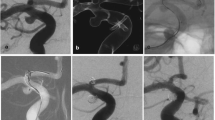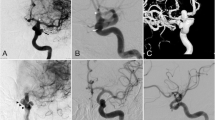Abstract
Background and Purpose
Intracranial adjacent tandem lesions of the internal carotid artery (ICA) are rare and the optimal treatment strategy is unknown. This study was carried out to determine whether a single flow diverter stent (FDS) could be successfully used to treat these lesions.
Methods
The prospectively maintained database was retrospectively carried out to identify patients treated between February 2009 and February 2018 with multiple unruptured, tandem ICA aneurysms and treated with a single FDS. Demographic data, clinical presentation, aneurysm characteristics, treatment data, clinical result and clinical and radiological follow-up information were recorded.
Results
A total of 69 patients (62 female, 89.8%) with average age 55 ± 14.8 years were identified. In total there were 169 aneurysms and the majority of patients (n = 47, 68.1%) had only 2 tandem aneurysms. The largest aneurysms measured 7.69 ± 5.3 mm (range 1.5–26 mm) in height, 6.64 ± 4.71 mm (range 1.5–23 mm) in width and the smaller aneurysm measured 2.61 ± 1.32 mm (range 0.8–9.5 mm) in height and 2.32 ± 1.12 mm (range 0.7–8 mm) in width. In 36 patients the p64 was used, the PED in 28 patients and Surpass in 5 patients. Follow-up was available in 54 patients (130 aneurysms). At initial follow-up (7.2 ± 4.2 months) 45 (83.3%) of the larger aneurysms and 66 (86.8%) of the smaller aneurysms were satisfactorily occluded (Raymond-Roy classification RRC 1 or 2). At delayed follow-up (18 ± 14.6 months) 48 of the larger aneurysms (88.9%) and 71 of the smaller aneurysms (93.4%) were satisfactorily occluded. There were three complications including one death.
Conclusion
A single FDS can be used to successfully treat multiple tandem aneurysms of the ICA with a high rate of aneurysm exclusion and an acceptable risk profile.



Similar content being viewed by others
References
Schievink WI. Genetics of intracranial aneurysms. Neurosurgery. 1997;40:651–62. discussion 662–3.
Schievink WI, Michels VV, Piepgras DG. Neurovascular manifestations of heritable connective tissue disorders. A review. Stroke. 1994;25:889–903.
Nekrysh SY. Association between heritable connective tissue disorders and intracranial aneurysms. Surg Neurol. 2000;54:77–8.
Kim ST, Brinjikji W, Kallmes DF. Prevalence of intracranial aneurysms in patients with connective tissue diseases: a retrospective study. AJNR Am J Neuroradiol. 2016;37:1422–6.
Raymond J, Guilbert F, Weill A, Georganos SA, Juravsky L, Lambert A, Lamoureux J, Chagnon M, Roy D. Long-term angiographic recurrences after selective endovascular treatment of aneurysms with detachable coils. Stroke. 2003;34:1398–403.
Fang YB, Zhang ZL, Yang PF, Wen WL, Hong B, Xu Y, Zhao WY, Huang QH, Liu JM. Stepwise stent deployment technique for tandem intracranial aneurysms: a review of 21 cases. Eur Radiol. 2016;26:351–8.
Lin N, Brouillard AM, **ang J, Sonig A, Mokin M, Natarajan SK, Krishna C, Hopkins LN, Snyder KV, Siddiqui AH, Levy EI. Endovascular management of adjacent tandem intracranial aneurysms: utilization of stent-assisted coiling and flow diversion. Acta Neurochir (Wien). 2015;157:379–87.
John S, Bain M, Cerejo R, Bauer A, Masaryk T, Hussain MS, Rasmussen P, Toth G. Flow diverter treatment of tandem intracranial aneurysms. World Neurosurg. 2017;107:142–7.
Chiu AH, Nadarajah M, Wenderoth JD. Cost analysis of intracranial aneurysmal repair by endovascular coiling versus flow diversion: at what size should we use which method? J Med Imaging Radiat Oncol. 2013;57:423–6.
Chalouhi N, McMahon JF, Moukarzel LA, Starke RM, Jabbour P, Dumont AS, Tjoumakaris S, Gingold EL, Rosenwasser R, Gonzalez LF. Flow diversion versus traditional aneurysm embolization strategies: analysis of fluoroscopy and procedure times. J Neurointerv Surg. 2014;6:291–5.
Cheung NK, Boutchard M, Carr MW, Froelich JJ. Radiation exposure, and procedure and fluoroscopy times in endovascular treatment of intracranial aneurysms: a methodological comparison. J Neurointerv Surg. 2018;10:902–6.
Adeeb N, Moore JM, Griessenauer CJ, Foreman PM, Shallwani H, Dmytriw AA, Shakir H, Siddiqui AH, Levy EI, Davies JM, Harrigan MR, Thomas AJ, Ogilvy CS. Treatment of tandem internal carotid artery aneurysms using a single pipeline embolization device: evaluation of safety and efficacy. AJNR Am J Neuroradiol. 2017;38:1605–9.
Lylyk P, Miranda C, Ceratto R, Ferrario A, Scrivano E, Luna HR, Berez AL, Tran Q, Nelson PK, Fiorella D. Curative endovascular reconstruction of cerebral aneurysms with the pipeline embolization device: the Buenos Aires experience. Neurosurgery. 2009;64:632–42. discussion 642–3; quiz N6.
Becske T, Brinjikji W, Potts MB, Kallmes DF, Shapiro M, Moran CJ, Levy EI, McDougall CG, Szikora I, Lanzino G, Woo HH, Lopes DK, Siddiqui AH, Albuquerque FC, Fiorella DJ, Saatci I, Cekirge SH, Berez AL, Cher DJ, Berentei Z, Marosfői M, Nelson PK. Long-term clinical and angiographic outcomes following pipeline embolization device treatment of complex internal carotid artery aneurysms: five-year results of the pipeline for uncoilable or failed aneurysms trial. Neurosurgery. 2017;80:40–8.
Becske T, Kallmes DF, Saatci I, McDougall CG, Szikora I, Lanzino G, Moran CJ, Woo HH, Lopes DK, Berez AL, Cher DJ, Siddiqui AH, Levy EI, Albuquerque FC, Fiorella DJ, Berentei Z, Marosfoi M, Cekirge SH, Nelson PK. Pipeline for uncoilable or failed aneurysms: results from a multicenter clinical trial. Radiology. 2013;267:858–68.
Fischer S, Vajda Z, Aguilar Perez M, Schmid E, Hopf N, Bäzner H, Henkes H. Pipeline embolization device (PED) for neurovascular reconstruction: initial experience in the treatment of 101 intracranial aneurysms and dissections. Neuroradiology. 2012;54:369–82.
Yu SC, Kwok CK, Cheng PW, Chan KY, Lau SS, Lui WM, Leung KM, Lee R, Cheng HK, Cheung YL, Chan CM, Wong GK, Hui JW, Wong YC, Tan CB, Poon WL, Pang KY, Wong AK, Fung KH. Intracranial aneurysms: midterm outcome of pipeline embolization device—a prospective study in 143 patients with 178 aneurysms. Radiology. 2012;265:893–901.
Saatci I, Yavuz K, Ozer C, Geyik S, Cekirge HS. Treatment of intracranial aneurysms using the pipeline flow-diverter embolization device: a single-center experience with long-term follow-up results. AJNR Am J Neuroradiol. 2012;33:1436–46.
Lanzino G, Crobeddu E, Cloft HJ, Hanel R, Kallmes DF. Efficacy and safety of flow diversion for paraclinoid aneurysms: a matched-pair analysis compared with standard endovascular approaches. AJNR Am J Neuroradiol. 2012;33:2158–61.
Funding
This research received no specific grant from any funding agency in the public, commercial or not-for-profit sectors.
Author information
Authors and Affiliations
Corresponding author
Ethics declarations
Conflict of interest
P. Bhogal serves as a proctor and consultant for phenox GmbH and Neurvana Medical. H. Henkes is a co-founder and shareholder of phenox GmbH. P. Lylyk serves as a proctor and consultant for phenox GmbH. J. Chudyk, C. Bleise, I. Lylyk and N. Perez declare that they have no competing interests.
Additional information
Author Contribution
P. Bhogal, J. Chudyk, C. Bleise data gathering, manuscript preparation; I. Lylyk, N. Perez, H. Henkes review, editing; P. Lylyk guarantor
Rights and permissions
About this article
Cite this article
Bhogal, P., Chudyk, J., Bleise, C. et al. Treatment of Unruptured, Tandem Aneurysms of the ICA with a Single Flow Diverter. Clin Neuroradiol 29, 725–731 (2019). https://doi.org/10.1007/s00062-018-0723-z
Received:
Accepted:
Published:
Issue Date:
DOI: https://doi.org/10.1007/s00062-018-0723-z




